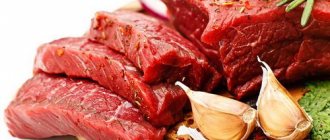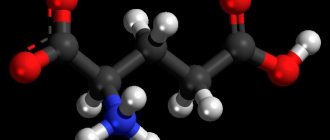Amino acids
Sergey Sidoruk 02/05/2019 no comments
3
Products containing amino acids
3.3 (65%) 4 votes
For proper and complete functioning of the body, chemicals are needed, which include amino acids.
Amino acids are the building material from which proteins and all living organisms are subsequently built. In the human system, all organs, muscles, hair, nails, and partly bones are made up of proteins. Proteins are chemical substances that transmit nerve impulses from cell to cell, supplying them with oxygen. These organic compounds are used by the body in the production of hormones, pigments and vitamins and are responsible for water balance.
A person is not able to produce all the necessary amino acids on his own and obtains some exclusively from food. A large number of these organic compounds that are important for human existence are known, ten of them are irreplaceable, about twenty more are found in food, and a person is able to obtain them from the outside.
Each amino acid has special functions that are very important for the full functioning of the body. Many essential amino acids are produced in the human liver, these are called “Replaceable”, those that the body is not able to produce are called “Irreplaceable”, that is, obtained from food, there are also those whose production depends on certain conditions (age criteria ), these are “Conditionally essential amino acids”. It is worth emphasizing that all the most important amino acids are found in food.
To grow and develop, the body needs foods that contain two main components - proteins and amino acids.
Replaceable: which products contain amino acids
Content
The list of “Replaceables” includes:
- Aminosuccinic acid - used for protein synthesis and muscle growth, found in brain cells, promoting concentration. Sources include meat products, dairy and fish.
- Carnosine and Alanine are responsible for maintaining the immune system, have antioxidant properties, and make muscle fibers resistant to heavy physical activity. Such amino acids are found in food products, for example, beef, fish, pork, yeast.
- Cysteine reduces pain, relieves inflammation, reduces the risk of cancer, and improves the condition of skin and hair. Its sources can be: corn, broccoli, dairy products, eggs.
- Glutamic acid has a beneficial effect on the production of growth hormone, transmits nerve impulses, and takes part in muscle contractions. Mushrooms, tomatoes, dried fruits, and seafood contain it in large quantities.
- Aminoacetic acid forms muscle tissue, has regenerating, anticancer, and immunostimulating properties. Sources include: cucumbers, cabbage, pumpkin, beans, fish, cheese.
- Ornithine takes part in the formation of urine, stimulates the process of fat burning, heals wounds, and improves immunity. The main suppliers are considered to be nuts, eggs, poultry and fish.
- Proline cleanses blood vessels, normalizes blood flow, restores damaged muscles and tendons, and takes part in the production of collagen. There is a high content of amino acids in foods: eggs, seaweed, nuts, whole grains.
- Taurine affects blood clotting and improves blood supply to the heart muscle, improves metabolic processes, has a beneficial effect on the respiratory system, and prolongs youth. A large amount of it is present in poultry meat, red fish, and seafood.
In order for the body to function and develop, a person needs a supply of 20 amino acids
- Serine is necessary for the production of serotonin (the hormone of happiness), immunoglobulins, and stimulates the production of muscle fibers. Serine is found in milk, cottage cheese, soybeans, and cauliflower.
- Glutamine can be converted, if necessary, into glutamic acid and back. It promotes cell regeneration, detoxification, immunostimulation, and prevents muscle breakdown. Rich in its presence: beans, parsley, asparagus, cottage cheese, red fish.
Classification
The table of amino acids reflects their classification by type: essential and essential.
All of them are necessary for the human body. All amino acids are divided into two groups:
- irreplaceable or essential. These are the amino acids that the human body cannot produce on its own. They come to us with food with a rational diet;
- replaceable. The body synthesizes them independently from those substances that come with food. But you should not underestimate them, so it is advisable that they also enter the body with food.
For ease of use, a table of amino acids has been compiled, from which it is easy to determine how many essential ones will enter the body. For simplicity, there are indicators in % and in grams.
We also recommend studying this topic:
How should you take Pureprotein Arginine Complex correctly?
Athletes are increasingly using sports nutrition to achieve and improve their results. One of the most effective complexes includes AAKG from the Pureprotein company.
https://www.youtube.com/watch?v=ytpolicyandsafety
This type includes:
- alanine It is a source of energy into the body's cells and allows you to accelerate the removal of toxins from the liver;
- arginine Allows you to normalize liver function, quickly restore muscles, strengthen the immune system;
- asparagine The action is similar to aspartic acid;
- aspartic acid. Allows you to normalize metabolic processes, activate energy synthesis, and also provides support for the nervous system.
- cysteine. It is involved in normalizing the condition of hair, as well as nails and skin. Helps relieve symptoms of cancer and bronchitis.
- glutamic acid. The action is similar to glutatin.
- glutamine Effectively removes toxins from the liver and takes part in muscle growth. Adds strength, endurance, and energy to the athlete.
- glycine. It restores the normal functioning of the nervous system.
- proline This amino acid improves the condition of human skin;
- serine Fills the body's cells with energy.
- tyrosine Increases brain activity, participates in the formation of muscle protein.
Table of amino acid content in each product in shares. Athlete's handbook.
A table of amino acids, including a list of all essential and essential ones, is like a reference book for athletes.
These include:
- histidine It is present in the human body and performs the functions of participating in the creation of blood cells. It is truly considered the basis of the immune system.
- isoleucine. Its priority function is to increase endurance, as well as restore energy;
- leucine The main amino acid for the human body, which is involved in the regeneration of muscle fibers. It allows you to stop catabolism. Leucine helps regulate sugar levels, burn fat deposits;
- lysine. Ensure the body fights viral diseases;
- methionine Helps fight fat. Improves endurance as well as strength;
- phenylalanine. The priority direction of the amino acid is to normalize the functioning of the nervous system;
- threonine This amino acid normalizes protein metabolism and stimulates muscle development;
- tryptophan. Functions: normalize blood pressure, improve sleep;
- valine Provides tissue regeneration and saturates the body with energy.
Read more: Cardio exercises for weight loss at home, aerobic workouts for burning fat at home
Table of amino acid content in milligrams in different foods. A balanced diet will help saturate the body with the required amount of amino acids, and you can supplement it with supplements from the sports nutrition series
Replaceable and essential amino acids, the table of which is presented in the article, will serve as a reference book not only for an athlete, but also for people who care about their health.
We also recommend studying this topic:
Purpose of glutamine, its properties and dosage regimen
Energy-intensive glutamine in bodybuilding supports the athlete’s immune system, participates in digestive and muscle tissue formation processes, and metabolic processes. L-glutamine prevents the process of muscle breakdown in a bodybuilder during active training using heavy weights.
Readers found these materials useful:
Conditionally replaceable: which products contain
Conditionally replaceable are amino acids that cannot be produced during certain periods of life (infancy and old age), or when there is an insufficient amount of components such as:
- arginine – necessary for the body where rapid growth of muscle mass is needed, to improve metabolic processes and immune function;
- tyrosine – transmits nerve signals, with its participation hormones are produced (including the “happiness hormone”) and pigments;
- histidine – enables the growth of muscle tissue and the production of enzymes;
- cysteine – supports the health of the visual organs, the nervous system, and the rapid development of muscles.
Conditionally replaceable ones are found in foods high in amino acids: legumes, bananas, nuts and seeds, poultry, beef and turkey, and seafood.
Essential amino acids enter our body with the food we eat.
Making the right menu
And so, we already know that our body must receive 8 essential amino acids with food, preferably every day. After all, their deficiency will soon make itself felt by serious health problems. It is necessary to find out which foods contain essential amino acids in order to properly formulate a diet.
And to do this, let's look at each essential amino acid separately: what it is responsible for and in what products to look for it.
Table of amino acid content in foods
| No. | Product | Amino acid content 100 g. product |
| Leucine – if there is a deficiency, liver problems and anemia occur. | ||
| 1. | Soybeans | 2.8 gr. |
| 2. | Hard cheese | 2.2 gr. |
| 3. | Seafood | 1.8-1.4 gr. |
| 4. | Legumes | 1.9-1.6 gr. |
| 5. | Nuts | 1.7-1.1 gr. |
| 6. | Meat | 1.8-1.2 gr. |
| 7. | Fish | 1.6-1.4 gr. |
| 8. | Cereals | 1.5-0.9 gr. |
| 9. | Eggs | 1.1 gr. |
| Isoleucine – hemoglobin synthesis, participation in energy processes, increases stress resistance, reduces fatigue | ||
| 1. | Soybeans | 1.8 gr. |
| 2. | Hard cheese | 1.5 gr. |
| 3. | Legumes | 1.1 gr. |
| 4. | Meat | 1.1 gr. |
| 5. | Fish | 0.9 gr. |
| 6. | Nuts | 0.7 gr. |
| Valine has a tonic effect on the body, maintains and strengthens normal muscle tone | ||
| 1. | Soybeans | 2.1 gr. |
| 2. | Legumes | 1.3 gr. |
| 3. | Meat | 1.1 gr. |
| 4. | Nuts | 1-0.7 gr. |
| 5. | Fish and seafood | 0.9 gr. |
| 6. | Eggs | 0.9 gr. |
| 7. | Cereals | 0.7 gr. |
| Lysine strengthens the immune system, promotes bone growth and collagen production | ||
| 1. | Soybeans | 2.1 gr. |
| 2. | Hard cheese | 1.95 gr. |
| 3. | Meat | 1.4-1.9 gr. |
| 4. | Fish | 1.5-1.9 gr. |
| 5. | Legumes | 1.5-1.7 gr. |
| 6. | Cottage cheese | 1 gr. |
| 7. | Soft cheese | 0.9 gr. |
| 8. | Eggs | 0.9 gr. |
| Methionine – increases the level of antioxidants, has detoxification ability, prevents the deposition of excess fats | ||
| 1. | Cheese | 0.5-0.6 gr. |
| 2. | Meat | 0.4-0.6 gr. |
| 3. | Fish and seafood | 0.5-0.6 gr. |
| 4. | Soybeans | 0.5 gr. |
| 5. | Legumes | 0.3-0.4 gr. |
| 6. | Eggs | 0.4 gr. |
| Threonine – promotes the removal of toxins, participates in the synthesis of collagen and elastin | ||
| 1. | Soybeans | 1.4 gr. |
| 2. | Legumes | 0.8-1 gr. |
| 3. | Fish | 0.9-1.1 gr. |
| 4. | Cottage cheese and cheese | 0.8-1 gr. |
| 5. | Meat | 0.7-0.9 gr. |
| 6. | Seafood | 0.8 gr. |
| 7. | Eggs | 0.6 gr. |
| 8. | Nuts | 0.6 gr. |
| Tryptophan – “responsible” for good mood, activity and mental abilities | ||
| 1. | Mozzarella cheese | 0.5 gr. |
| 2. | Soybeans | 0.5 gr. |
| 3. | Hard cheese | 0.3 gr. |
| 4. | Legumes | 0.3 gr. |
| 5. | Fish, meat and eggs | 0.2 g each |
| Phenylalanine – stimulates brain function, the production of endorphins, improves memory and mental abilities | ||
| Soybeans | 1.6 gr. | |
| Legumes | 1.3-1.5 gr. | |
| Nuts | 1-1.3 gr. | |
| Fish | 0.8-1 gr. | |
| Cheese | 1-1.2 gr. | |
| Meat | 0.7-1 gr. | |
| Eggs | 0.7 gr. | |
To be absolutely precise, there is also a third group of amino acids, which are called conditionally essential. This:
- arginine;
- histidine;
- cystine;
- tyrosine
They are synthesized by the body of an adult healthy person in the required quantity. But for children, adolescents and the elderly it is vital to get them from food.
Essential amino acids (AA)
When creating a menu for yourself, especially when losing weight, you need to choose products that contain essential amino acids in the right quantities and know how they act on the body.
Let's consider which amino acids are classified as essential - these are those that the body is not able to synthesize on its own:
- Valine saves people from stress, is effective in stimulating tissue and muscle growth, is an antidepressant, and neutralizes sudden temperature changes in the environment.
- Leucine is the natural basis of proteins. Leucine is found in the blood, glands and organs, and is indicated for muscle tissue dystrophy, exhaustion of the nervous system, and decreased hemoglobin in the blood.
- Isoleucine regulates blood glucose levels, accelerates metabolism, takes part in the production of blood and lymph, bone restoration, and increases endurance during physical activity.
- Lysine has the ability to provide the heart muscle with oxygen and nutrients through blood transport, activates the production of immune antibodies, and has an antiviral effect.
- Phenylalanine is an antidepressant that improves memory and emotional state, reduces appetite, and reduces pain.
- Methionine increases muscle tone, removes toxic substances and reduces the effects of radiation exposure, and is involved in the production of collagen.
- Tryptophan has a sedative effect, activates the production of growth hormone, relieves spasms of various etiologies, and alleviates migraine pain.
- Threonine is responsible for the production of connective and muscle tissue, the production of antibodies, and prevents the production of fat cells.
Due to the fact that a person does not produce the above substances on his own, let us consider using the table “Foods with a high content of amino acids”:
Table of amino acid content in food
| Product | Protein, % | Amino acids (mg per 100 g net product) | ||||||||
| Tryptophan | Lysine | Methionine | Valin | Threonine | Leucine | Isoleucine | Phenylalanine | Histidine | ||
| Chicken egg | 12,7 | 204 | 903 | 424 | 772 | 610 | 1081 | 597 | 652 | 340 |
| Cow's milk | 3,2 | 50 | 261 | 87 | 191 | 153 | 324 | 189 | 171 | 90 |
| Meat | ||||||||||
| beef 1st category | 18,6 | 210 | 1589 | 445 | 1035 | 803 | 1478 | 782 | 795 | 710 |
| beef 2nd category | 20,0 | 228 | 1672 | 515 | 1100 | 859 | 1657 | 862 | 803 | 718 |
| veal 1st category | 19,7 | 245 | 1683 | 414 | 1156 | 855 | 1484 | 998 | 791 | 739 |
| veal 2nd category | 20,4 | 260 | 1755 | 453 | 1177 | 892 | 1566 | 1050 | 828 | 740 |
| pork meat | 14,3 | 191 | 1239 | 342 | 831 | 654 | 1074 | 708 | 580 | 575 |
| rabbits | 21,1 | 327 | 2199 | 499 | 1064 | 913 | 1734 | 864 | 512 | 626 |
| chickens of the 1st category | 18,2 | 293 | 1588 | 471 | 877 | 885 | 1412 | 653 | 744 | 486 |
| chickens of the 2nd category | 20,8 | 330 | 1699 | 574 | 899 | 951 | 1824 | 828 | 896 | 379 |
| turkeys 1st category | 19,5 | 329 | 1636 | 417 | 930 | 875 | 1587 | 963 | 803 | 540 |
| turkeys 2nd category | 21,6 | 354 | 1931 | 518 | 1017 | 961 | 1819 | 1028 | 851 | 436 |
| beef liver | 17,9 | 238 | 1433 | 438 | 1247 | 812 | 1594 | 926 | 928 | 847 |
| beef kidneys | 15,2 | 214 | 1154 | 326 | 857 | 638 | 1240 | 714 | 677 | 687 |
| beef tongue | 16,9 | 176 | 1373 | 345 | 845 | 708 | 1215 | 766 | 696 | 616 |
| Sausage | ||||||||||
| doctorate | 12,8 | 151 | 945 | 177 | 672 | 529 | 913 | 547 | 508 | 318 |
| milk sausages | 11,4 | 203 | 839 | 111 | 630 | 357 | 757 | 313 | 369 | 302 |
| Fish | ||||||||||
| cod | 16,0 | 210 | 1500 | 500 | 900 | 900 | 1300 | 1500 | 800 | 450 |
| pollock | 15,9 | 200 | 1800 | 600 | 900 | 900 | 1300 | 1100 | 700 | 400 |
| sea bass | 18,2 | 170 | 1700 | 500 | 1000 | 900 | 1600 | 1100 | 700 | 400 |
| carp | 16,0 | 180 | 1900 | 500 | 1100 | 900 | 1800 | 800 | 800 | 300 |
| zander | 18,4 | 184 | 1619 | 534 | 975 | 791 | 1398 | 938 | 681 | 400 |
| Atlantic herring | 19,0 | 250 | 1800 | 350 | 1000 | 900 | 1600 | 900 | 700 | 500 |
| squid | 18,0 | 324 | 2005 | 521 | 500 | 648 | 2070 | 432 | 216 | 324 |
| Cottage cheese | ||||||||||
| lean | 18,0 | 180 | 1450 | 480 | 990 | 800 | 1850 | 1000 | 930 | 560 |
| fatty | 14,0 | 212 | 1008 | 384 | 838 | 649 | 1282 | 690 | 762 | 447 |
| Hard cheese | 26,8 | 788 | 1747 | 865 | 1414 | 1067 | 1780 | 1146 | 1280 | 1508 |
| Soybeans | 34,9 | 450 | 2090 | 560 | 2090 | 1390 | 2670 | 1810 | 1610 | 620 |
| Peas | 23,0 | 260 | 1660 | 250 | 1100 | 930 | 1650 | 1330 | 1110 | 600 |
| Beans | 22,3 | 260 | 1590 | 280 | 1120 | 870 | 1740 | 1030 | 1130 | 630 |
| Groats | ||||||||||
| buckwheat | 12,6 | 180 | 630 | 260 | 590 | 500 | 680 | 520 | 540 | 300 |
| oatmeal | 11,9 | 160 | 420 | 140 | 580 | 350 | 780 | 500 | 550 | 220 |
| rice | 7,0 | 80 | 260 | 130 | 420 | 240 | 620 | 330 | 350 | 160 |
| Poltava | 12,7 | 90 | 280 | 140 | 380 | 300 | 680 | 330 | 580 | 250 |
| pearl barley | 10,4 | 100 | 300 | 120 | 490 | 320 | 490 | 460 | 460 | 190 |
| barley | 9,3 | 120 | 320 | 160 | 450 | 210 | 510 | 560 | 490 | 230 |
| millet | 12,1 | 180 | 360 | 270 | 620 | 440 | 1620 | 590 | 580 | 290 |
| pasta | 12,3 | 125 | 249 | 189 | 518 | 331 | 866 | 470 | 626 | 261 |
| 1st grade wheat flour | 10,6 | 120 | 290 | 160 | 510 | 330 | 880 | 530 | 580 | 240 |
| Flour products | ||||||||||
| Rye bread | 5,5 | 67 | 186 | 62 | 268 | 175 | 356 | 207 | 309 | 103 |
| wheat bread made from 2nd grade flour | 8,4 | 97 | 229 | 138 | 384 | 274 | 538 | 303 | 391 | 172 |
| sliced loaves from 1st grade flour | 7,4 | 83 | 165 | 117 | 330 | 213 | 553 | 295 | 395 | 166 |
| “Oktyabrenok” bun for baby food | 11,1 | 126 | 423 | 318 | 503 | 394 | 913 | 494 | 442 | 237 |
| Potato | 2,0 | 28 | 135 | 26 | 122 | 97 | 128 | 86 | 98 | 23 |
Now you can plan your diet yourself, knowing which foods contain amino acids.
Read more: What percentage of body fat should it be The whole truth
Purpose of essential amino acids
Proteins and NAC are of great importance for the proper functioning of all systems of the human body. Protein that comes from outside is the most complete when it has a balanced composition. The need for NAC increases sharply with intense sports and a high risk of injury. It is impossible to build muscle mass if there is a lack of AA in the body. To quickly recover from physical and stressful activities, burn fat and maintain excellent shape, it is necessary to consume foods rich in NAC for their correct balance in the complex system of human functioning.
Daily intake of AK
Amino acid requirements vary depending on health status, age, quality of life, and the amount and intensity of physical activity. It is necessary to clearly understand and regulate the quantitative composition of amino acids in the body. Thus, the normal daily dose of consumption is determined to be 0.5-2 grams per day.
It is very important to remember that if there are problems with the absorption of these substances, allergic reactions may occur. The need for their additional intake greatly increases during active physical and mental stress, during periods of intensive growth, during the fight against diseases and during the recovery period.
How to get amino acids?
The role of AK in people's lives is of enormous importance at any period of life. To restore this complex and necessary balance during a normal rhythm of life, it is enough to consume foods rich in amino acids. However, this is not enough for professional athletes, people seeking to build muscle mass, and for those whose profession or lifestyle involves increased stress of an extreme nature. In such cases, it is better to use special organic complexes with a high content of amino acids.










